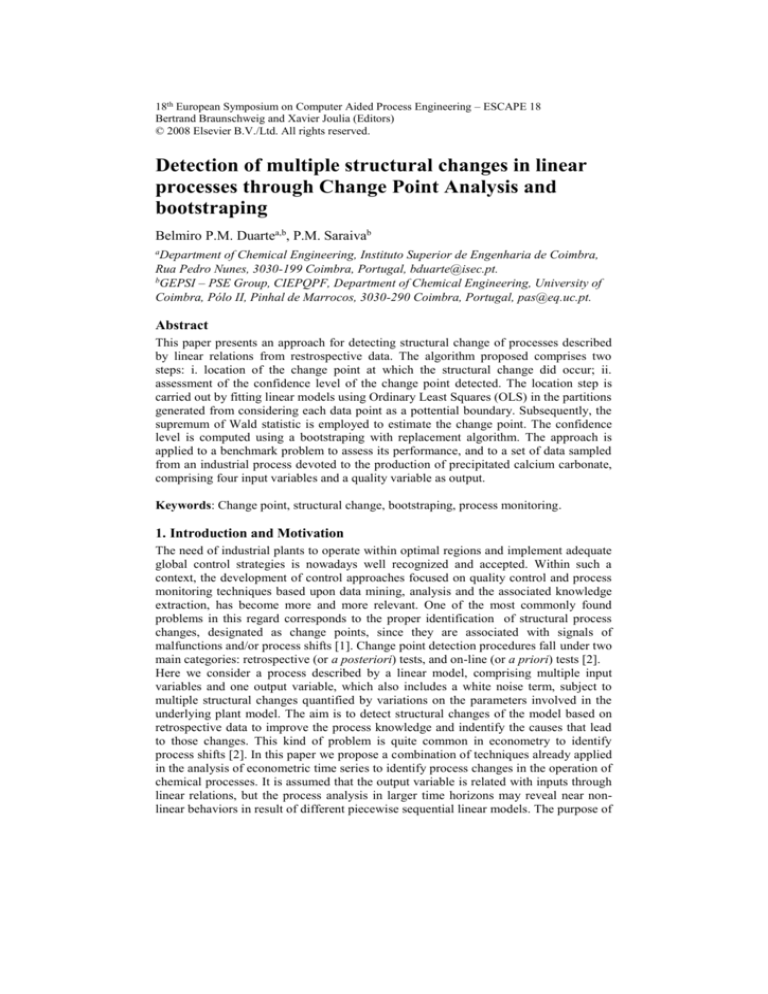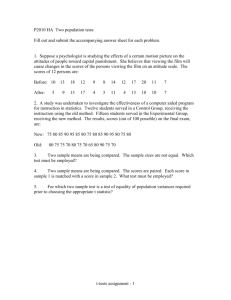
18th European Symposium on Computer Aided Process Engineering – ESCAPE 18
Bertrand Braunschweig and Xavier Joulia (Editors)
© 2008 Elsevier B.V./Ltd. All rights reserved.
Detection of multiple structural changes in linear
processes through Change Point Analysis and
bootstraping
Belmiro P.M. Duartea,b, P.M. Saraivab
a
Department of Chemical Engineering, Instituto Superior de Engenharia de Coimbra,
Rua Pedro Nunes, 3030-199 Coimbra, Portugal, bduarte@isec.pt.
b
GEPSI – PSE Group, CIEPQPF, Department of Chemical Engineering, University of
Coimbra, Pólo II, Pinhal de Marrocos, 3030-290 Coimbra, Portugal, pas@eq.uc.pt.
Abstract
This paper presents an approach for detecting structural change of processes described
by linear relations from restrospective data. The algorithm proposed comprises two
steps: i. location of the change point at which the structural change did occur; ii.
assessment of the confidence level of the change point detected. The location step is
carried out by fitting linear models using Ordinary Least Squares (OLS) in the partitions
generated from considering each data point as a pottential boundary. Subsequently, the
supremum of Wald statistic is employed to estimate the change point. The confidence
level is computed using a bootstraping with replacement algorithm. The approach is
applied to a benchmark problem to assess its performance, and to a set of data sampled
from an industrial process devoted to the production of precipitated calcium carbonate,
comprising four input variables and a quality variable as output.
Keywords: Change point, structural change, bootstraping, process monitoring.
1. Introduction and Motivation
The need of industrial plants to operate within optimal regions and implement adequate
global control strategies is nowadays well recognized and accepted. Within such a
context, the development of control approaches focused on quality control and process
monitoring techniques based upon data mining, analysis and the associated knowledge
extraction, has become more and more relevant. One of the most commonly found
problems in this regard corresponds to the proper identification of structural process
changes, designated as change points, since they are associated with signals of
malfunctions and/or process shifts [1]. Change point detection procedures fall under two
main categories: retrospective (or a posteriori) tests, and on-line (or a priori) tests [2].
Here we consider a process described by a linear model, comprising multiple input
variables and one output variable, which also includes a white noise term, subject to
multiple structural changes quantified by variations on the parameters involved in the
underlying plant model. The aim is to detect structural changes of the model based on
retrospective data to improve the process knowledge and indentify the causes that lead
to those changes. This kind of problem is quite common in econometry to identify
process shifts [2]. In this paper we propose a combination of techniques already applied
in the analysis of econometric time series to identify process changes in the operation of
chemical processes. It is assumed that the output variable is related with inputs through
linear relations, but the process analysis in larger time horizons may reveal near nonlinear behaviors in result of different piecewise sequential linear models. The purpose of
2
B.P.M. Duarte and P.M. Saraiva
the approach is particularly focused on the detection of the points where one piecewise
linear relation is replaced by another, thus indicating the occurrence of important shifts
on the process.
2. Structural change detection algorithm
Here we consider that the retrospective data, termed D X ,Y , was discretely
sampled from a process, with D s 1 , X s representing the input vector, and
Y the output. The sequences Y i ,1 i N , and X i ,1 i N are observations
sampled at instants t 0 i t , where t 0 is the initial absolute reference time, t is the
sampling time, and N is the number of observations. The process follows a linear
regression model :
Y i X iT i i
(1)
with standing for the random error, N (0, 2 ) and s for the vector of
parameters. One assumes that no structural change occurs during the first m records of
the data sample, a common assumption in structural change identification designated by
non-contamination condition, represented by the relation i 0 , 1 i m [3].
The purpose is to test the model structural stability, designated as null hypothesis H 0
vs. the occurrence of model structural changes at point k , with 1 m k N , denoted
as hypothesis H 1 . Several test procedures can be employed for such a purpose. Among
them are all tests belonging to the generalized fluctuation test framework [4], the tests
based on Maximum Likelihood scores [5], and the tests derived from the F statistic [6].
Recently Zeileis demonstrated that all three families of tests can be unified into a
framework designated as generalization of M-fluctuation tests [7]. The family of tests
based on F statistics, such as the Wald statistic and likelihood ratio were developed for
testing the occurrence of a single structural change at an unknown time instant [8]. We
address a similar problem, thus choosing the sup W test [6], belonging to the F statisticbased tests, for the purpose of testing the null hypothesis. It must be stressed that one
assumes that the underlying process has an unknown number of structural changes,
which are determined one at a time by iteratively partitioning and testing the original
data set.
The model estimation algorithm employed is OLS, and the methodology is described as
follows. For each k partition comprising the observations 1, ,k the associated leastsquares estimates of , termed as k , are obtained through the minimization of
k
i 1
y X
i
observations
T
i
k
2
k 1,
. The complementar set of the partition k , denoted as k , includes
, N , and the associated least squares estimates of k are
computed by the minimization of
N
i k 1
y X
i
T
i
k
. The sum of square residuals
2
for each of the pottential k partitions considered under the H 1 hypothesis depends on
the break point k , and is given as:
Detection of multiplestructural changes in linear processes through Change Point
Analysis and bootstraping
3
k
S (k ) y i X iT k
i 1
2
y
N
i k 1
i
X iT k
2
(2)
The Wald statistic can now be constructed, assuming that the covariance matrix of the
residuals is heteroskedastic [9] :
W k
S (N ) S (k )
S (k ) /(N s )
(3)
where S (N ) is the sum of square residuals of the model fitted under the null
hypothesis. The change point, ˆ , is therefore estimated as :
ˆ sup W (k ) , k N ,(1 )N
(4)
with =0.15, the fraction of points considered to define a non-contamination condition
[6]. Next to the assessment of the change point one has to validate it deriving
confidence intervals for its occurrence. In the literature two basic strategies are
employed for such a purpose: i. the deveolpment of proper analytical assymptotic
estimators for the statistic ˆ ; ii. the use of bootstraping algorithms. The bootstraping
technique was firstly proposed by Effron and Tibshirani to build an approximation of
the distribution of a test statistic [10]. The idea behind its application is to create a new
sample by drawing the error terms from the empirical distribution produced by the null
hypothesis model, where no break exists. Each bootstrap sample serves to compute a
test statistic ˆ* in the same fashion as ˆ . Here we employ a parametric bootstrap
technique standing on a data-generating process described by a parametric distribution
of i arising from fitting the model yi X iT (N ) i with the complete set of data. An
uniform distribution that assigns probability 1/ N is used to sample with replacement
the values of i and build a new distribution of the error, i* , subsequently employed
to build a new distribution of the output, denoted as y i* [11]:
y i* X iT (N ) i*
(5)
and a new data sample D * X ,Y * is then used to determine the bootstrap change
point ˆ* . The degree of confidence of ˆ is therefore given by:
p ˆ
1
B
I ˆ ˆ
B
*
(6)
i 1
where I is an indicator function whose value is 1 if its argument is true and 0 if not,
and B is the number of bootstrap samples. In case p ˆ 1 a structural change
occurred at the point ˆ and both partitions 1,
,ˆ and ˆ 1,
,N are subsequently
4
B.P.M. Duarte and P.M. Saraiva
tested (one at a time) regarding the occurrence of structural changes, with standing
for the Type I error assumed. This procedure is carried out iteratively until no more
change points found achieve probabilities higher than 1 .
3. Application
The algorithm described in Section 2 was tested with two data samples. The process has
a structural change at the point ˆ 50 , which is captured with 100% of confidence, and
no more change points are identified. The values of B and employed were 399 and
0.01, respectively, in both cases handled. The number of bootstraps was chosen taking
into account the empirical rule of Davidson and MacKinnon, who proposed that
B 1 should be an integer in order to achieve an exact test [12]. The power of the
test increases as B increases, however the computational effort also augments
proportionally, thus requiring an appropriate trade-off between those two factors.
The first data set represents a benchmark problem with a single input and a single
output, with the data generated according to the relation :
1 i 50
y i 5.0 0.1x i z i
5.0 0.1x i z i 51 i 100
xi i ,
i 1, ,100
(7)
and z N (0,0.2) standing for normal noise, and i is an integer counter. Figure 1
reveals the accuracy of the algorithm, and Table 1 presents the stuctural form of the
local models identified. The change point is located at observation 50 due to noise of the
output variable, as can be seen from Figure 1. Moreover, the local models identified are
in close agreement with the data, thus proving the accuracy of the algorithm.
Table 1 – Structural models for each of the regions.
Region
Interval
1
[1;49]
[4.8852
-0.0970]T
2
[50;100]
[-5.6084
0.1010]T
The second case used for testing the methodology is about an industrial unit devoted to
the production of precipitated calcium carbonate (PCC). The process dynamics are
monitored measuring an output variable which is simultaneously a quality variable, and
four input variables which affect the former. The data set used for analyzing the
occurrence of structural changes is formed by 93 records respecting to almost 3 months
of operation. One may see from Figure 2.a that 2 structural changes were identified,
with the order representing the sequence of change points detected. The visual analysis
of the output variable does not reveal different trends, but the structural changes
correspond to different linear models (Table 2). The quality variable exhibits an almost
random behavior due to the changes of the input variables. Additionally, the magnitude
of inputs becomes larger for t 30 days, thus leading to an increase of the model
residuals (Figure 2.b). However, our approach is able to capture changes in regression
coefficients. Although with a different variation, due to model structural and input
Detection of multiplestructural changes in linear processes through Change Point
Analysis and bootstraping
5
changes, one can see from Figure 2 that no underlying structure seems to be present in
the zero centered residuals, apparently confirming that linear input-output relationships
do convey a good approximation about this plant´s behaviour. The statistical analysis of
the residuals produced by three local model stucture revealed its independency on the
inputs and normality
Figure 1 – Results for Case 1 (CPi identifies ith change point and for the Type I error
probability).
Table 2 – Structural models for each of the regions.
Region
Interval
1
[1;33]
[10.9877 -0.0101 -0.4398 -2.6186 -1.7795]T
2
[34;62]
[39.1254 0.1533 26.3165 36.3046 -91.9578]T
3
[62;93]
[63.1440 -0.2038 -88.8527 -34.4503 178.7011]T
4. Conclusion
In this paper a methodology often used in the analysis of econometric time series
(Change Point Analysis) is employed to detect structural changes of the process model
of production units based on retrospective data series. The process model is linear and
OLS is used to fit the data. The detection of a single change point estimator at an
unknown instant is performed employing the sup W test, a tool included in the group of
F statistics tests. The construction of confidence level intervals for such an estimator is
carried out through a bootstrap technique based on sampling with replacement of the
error terms of the model associated to the null hypothesis. The detection of change
points and validation through the computation of its confidence level is performed
sequentially by partitioning the original data into smaller regions, where no change
point is found. The approach was successfully applied to a benchmark process model an
to an industrial set of data representing the dynamics of a process unit during a certain
time horizon.
6
B.P.M. Duarte and P.M. Saraiva
Figure 2 – Results for Case 2 - Plot a. Behaviour of the quality variable and change points where
CPi identifies ith change point and stands for the Type I error probability; Plot b. L ocal model
residuals .
References
1. F. Li, G.C. Runger, E. Tuv, Inter. J. Prod. Res., 44 (2006) 2853-2868.
2. M. Basseville, I.V. Nikorov, Detection of abrupt changes – theory and applications,
Prentice Hall (1993).
3. C.-S. J. Chu, M. Stinchcombe, H. White, Econometrica, 64 (1996) 1045-1065.
4. L. Horváth, M. Husková, P. Kokoszka, J. Steinbach, J. Stat. Planning and Inference,
126 (2004) 225-251.
5. B.E. Hansen, J. Policy Modeling, 14 (1992) 514-533.
6. D.W.K. Andrews, Econometrica, 61 (1993) 821-856.
7. A. Zeileis, Econometric Reviews, 24 (2005) 445-466.
8. J. Bai, P. Perron, Econometrica, 66 (1998) 47-78.
9. J. Bai, Econometric Theory, 13 (1997) 315-352.
10. B. Efron, R.J. Tibshirani, An introduction to the bootstrap, Chapman & Hall
(1994).
11. J. Jouini, M. Boutahar, Working paper, http://www.edgepage.net/jamb2003/Jamboree-Greqam-Jouini.pdf (2003).
12. R. Davidson, J. MacKinnon, Econometric Reviews, 19 (2000) 55-68.









